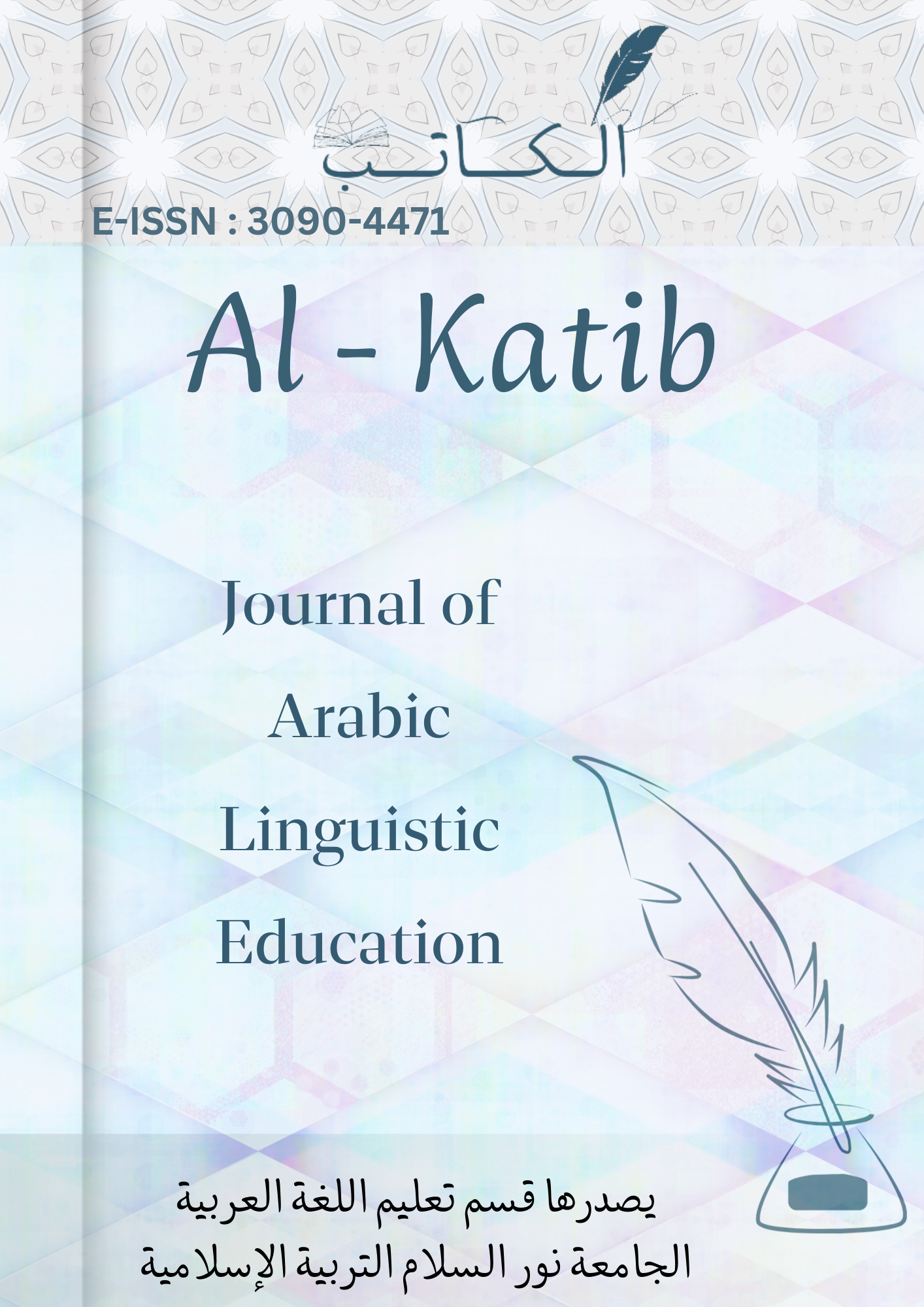IMPERATIVE FEATURES IN ARABIC TEXTBOOK FOR MADRASAH ALIYAH: REPRESENTATION AND LEARNING IMPLICATIONS
Keywords:
Imperative, Arabic Language Textbook, Learning ImplicationsAbstract
This study uses a descriptive qualitative research method with content analysis on the Arabic language textbook for Madrasah Aliyah. The purpose of this study is to analyze the use of imperative features in the form of imperative verbs and their implications for learning. Data were collected through direct observation of relevant sentences, focusing on identifying forms of imperative verbs in patterns such as tsulatsi mujarrad, tsulatsi mazid, ruba'i mujarrad, and ruba'i mazid. Each imperative verb form found was analyzed to identify its morphological patterns and semantic meanings within the context of Arabic language learning. The data analysis techniques include morphological analysis to determine the transformation from regular verbs to imperative verbs, as well as semantic analysis to understand the meaning of each imperative verb in its sentence. The research results indicate that the use of imperative verbs in the Arabic language textbook includes various wazan patterns and is used to give clear instructions to students within the learning context. The learning implications of using imperative verbs are related to the application of learning theories, such as social learning theory, cognitive theory, and task-based learning, which support students' understanding of language structure and its application in everyday communication.
References
Al-Khumairi, A. A. (2019). Analisis Impertif dalam Al Qur’an Surat Yāsīn. El-Afkar: Jurnal Pemikiran Keislaman Dan Tafsir Hadis, 8(1), 111–128.
Annisa, M. N., & Safii, R. (2023). Analisis Kebutuhan Belajar Bahasa Arab sebagai Bahasa Asing dalam Konteks Pendidikan Tinggi. ELOQUENCE: Journal of Foreign Language, 2(2), 313–328.
Bandura, A. (1977). Social Learning Theory. Englewood Cliffs.
Dahlan, Z. (2018). Khazanah kitab kuning: Membangun sebuah apresiasi kritis. ANSIRU PAI: Pengembangan Profesi Guru Pendidikan Agama Islam, 2(1), 1–19.
Darise, G. N. (2021). Pendidikan Agama Islam Dalam Konteks “Merdeka Belajar.” Journal of Islamic Education: The Teacher of Civilization, 2(2).
Hasanuddin, M. I. (2018). Ta’lim Fi’il Amr min Khilal Kitab Muqarrar al-Lugah al-’Arabiyyah fi al-Fashl al-Tsamin fi al-Madrasah al-Tsanwiyah Batu Sitanduk fi Manthiqah Walenran al-Syimaliyyah Mudiriyyh Luwu (dirasah sharfiyyah thatbiqiyyah). AL IBRAH: Journal of Arabic Language Education, 1(1), 87–100.
Hasibuan, H. A.-R., & Imawan, D. H. (2024). KARAKTERISTIK HADITS DAN MUHADDIS NUSANTARA STUDI PEMIKIRAN SYEIKH NAWAWI AL-BANTANI. Al-Hikmah: Jurnal Studi Agama-Agama, 10(1), 40–52.
Hayuningparasati, K., & Kuswardono, S. (2019). FI’IL AMR DAN FI’IL NAHYI DALAM ALQURAN (ANALISIS MORFOSINTAKSIS). Lisanul Arab: Journal of Arabic Learning and Teaching, 8(1), 67–73.
Krashen, S. (1981). Second Language Acquisition. Second Language Learning, 3(7), 19–39.
Krisman, N. (2022). Problem dan Tantangan Pembelajaran Kitab Kuning di Indonesia. Tsamratul Fikri| Jurnal Studi Islam, 16, 77–88.
Maulana, D. (2019). Analisis Kalimat Perintah (Amr) pada Surah Yāsīn dalam Terjemahan Al-Qur’an Bacaan Mulia HBJ. ALSUNIYAT: Jurnal Penelitian Bahasa, Sastra, Dan Budaya Arab, 2(1), 1–14.
Ratmelia, Y. (2018). Nilai Moral dalam Buku Teks Pelajaran Sejarah. Historia: Jurnal Pendidik Dan Peneliti Sejarah, 1(2), 177–184.
Saleh, U. S., & Nasrulloh, N. (2024). Analisis Morfosemantik Fi’il Amr dalam Al-Qur’an Surah Al-Kahfi. A Jamiy: Jurnal Bahasa Dan Sastra Arab, 13(1), 412–426.
Sehri, A. (2020). Analisis Struktur Makna Fi’l Amr Dalam Al-Qur’an Surah Al-Nur. Albariq: Jurnal Pendidikan Bahasa Arab, 1(2), 17–30.
Setyawan, M. Y. (2021). Kajian Makna dalam Kalimat Perintah (Uslūb Al-amr): Struktur dan Fungsi. El-Jaudah: Jurnal Pendidikan Bahasa Dan Sastra Arab, 2(2), 36–51.
Suroiyah, E. N., & Zakiyah, D. A. (2021). Perkembangan Bahasa Arab Di Indonesia. Muhadasah: Jurnal Pendidikan Bahasa Arab, 3(1), 60–69.
Susanto, H., & Purwanta, H. (2022). Analisis Pola Narasi Reflektif Buku Teks Sejarah SMA Untuk Pencapaian Empati Sejarah. Yupa: Historical Studies Journal, 6(1), 45–62.
Sya’bani, M. Z., & Has, Q. A. Bin. (2023). Relevansi Bahasa Arab dalam Dakwah: Refleksi atas kedudukan bahasa arab sebagai bahasa Al-Quran (Tinjauan Literatur). Ath-Thariq: Jurnal Dakwah Dan Komunikasi, 7(1), 97–111.
Syarofah, A., & Barry, M. Y. F. (2020). Bahasa Arab MA Kelas XII. Kementerian Agama Republik Indonesia.
Triansyah, F. A., Arif, H. M., Munirah, M. P., Romadhianti, R., Prastawa, S., Fajriana, K., Wachyudi, K., & Iman, M. N. (2023). Pemahaman Kurikulum dan Buku Teks. Cendikia Mulia Mandiri.
Vygotsky, L. S. (1978). Socio-Cultural Theory. Mind in Society, 6(3), 23–43.
Willis, J. (2021). A Framework for Task-Based Learning. Intrinsic Books Ltd.





